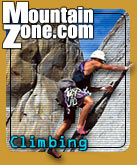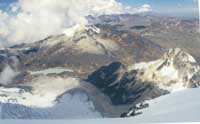
|
First Time Ascents into Bolivian Splendor July 21, 2003 Pages »1 2
My newfound obsession with mountaineering came with a price just a few minutes after the euphoria as I was becoming increasingly aware of the ill effect of altitude. My head felt like a watermelon split open with a sledgehammer. Sensing my discomfort (my unabated moaning must have been a giveaway) Fernando assured me that it was normal, though during the two-hour slog to base camp the pain still hadn't subsided. In fact, it only got worse. It was like a hangover that no amount of Kung Pao Chicken and mindless television would cure. Crippling pain wracked the base of my skull, convincing me I was going to die. Fernando slipped me 500mg of Paracetamol and sent me off to bed with assurances that I would be fine in the morning. Babies don't sleep that well. I was out for 10 hours. I awoke at dawn the next day feeling refreshed and ready to tackle our next peak, the slightly taller though much more difficult Pico Milluni summit on the other side of the valley. My appetite was still in check even though my body was starving. I must have lost 3 pounds the day before, yet all I could take down was a piece of bread and a cup of coca tea, a local remedy for altitude-induced nausea that's supposed to help the digestion. Feeling fine and fit, I still had no appetite and my belt was down to the last notch. If only dieters would head to the hills... So, Pico Milluni it was. Its glacier was an ashen-colored multi-million ton mass of black ice, rocks and hidden dangers like the dirty snow that clings to the underside of your car all winter long. The glacier's face was riddled with crevasses and depressions that seemingly had no bottom when you dared peer into them.
My guide and I roped together for additional safety, the need for which was becoming very apparent when my left leg slipped into a hidden crevasse, pulling the rope to my guide taut and sending me panic-stricken toward the abyss. "Don't walk on the white snow," said Fernando calmly. "They hide deep crevasses." "Important safety tip. Thanks Fernando," I thought bitterly. "Thanks for waiting two days and 16,000 vertical feet to tell me." We climbed tirelessly for the next three hours without incident other than a tumbling softball-sized rock narrowly missing my right temple by about 3 feet. "Watch out for avalanches," said Fernando in halting Spanish. We'd been making good progress, but the summit refused to get any closer until we reached what is known as the climb's crux, or the most technically difficult part. Pico Milluni's crux is a 100-foot scramble up a section of rock that included some vertical climbing. At a normal altitude, it would have posed little difficulty to a novice rock jock. But at 17,400 feet, it was daunting to even my experienced guide, a man with several dozen 20,000-plus summits under his belt. Fernando approached the crux with a military tactician's determination for conquest and set about scrambling up the face to place protective ropes. After 20 minutes or so, he signaled that it was my turn. Daunted out of my wits, I placed my hands into a crack looking for a hold while my crampons-clad boots scraped the rock face looking for a foothold. The metal spikes caught a tiny lip and held, allowing me to yank my torso clumsily up the face. Fifteen minutes later at the top of the crux I sucked greedily all the air I could. Still it wasn't enough. Fernando, also winded by our exertion, implored me in his limited English to "take drinks of oxygen." At that height his ability to communicate in any language had been reduced to just the vital elements for understanding. "Rest, then we finish the climb," my mountain sensei implored. "No problem with that," I responded, head back, hoping that some extra oxygen molecules might trickle down my trachea and fill my air-starved lungs.
The tiny peak finally began to grow larger during the last 100 feet. We were able to stand upright once again and pursue the summit walking. Our steps were slow and deliberate when approaching Pico's 18,799 ft peak. With less than a dozen steps to go we remained solemn in our steadfast pursuit of the summit, the silence broken only when we reached the top and let out a joint whoop for joy. -- Carmen Gentile is United Press International's Latin America Correspondent based in Sao Paulo, Brazil. In addition to his reporting on the region, Carmen also enjoys climbing, surfing and biking. He can be reached at cgentile@upi.com.
|
||||||||||||||||

